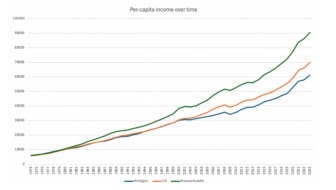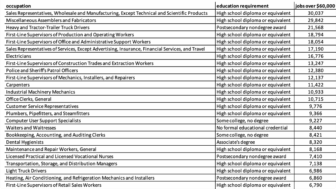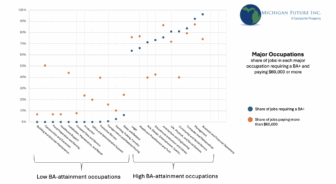The Michigan Association of United Ways recently released a 2024 update to their 2023 ALICE report. ALICE stands for Asset Limited, Income Constrained, Employed, and the ALICE rate captures the share of Michigan households with incomes below the “ALICE threshold,” the estimated income a household needs to pay for basic expenses like housing, childcare, food, and transportation. The ALICE threshold for most family compositions is more than double the federal poverty line.
Because of the time lag that accompanies Census Bureau data, the 2023 report covered data from 2021, during the heart of the pandemic. The 2024 provides a snapshot of how Michiganders were faring in 2022, as the worst impacts of the pandemic receded.
The 2023 report captured the state of financial hardship in Michigan at an interesting time. On the one hand, in 2021 Michigan’s economy was still reeling from the impacts of the pandemic, with an average unemployment rate near six percent. On the other hand, in 2021 households saw unprecedented levels of cash-based support from the federal government, through additional rounds of “stimulus checks,” expanded unemployment assistance, and the introduction of an expanded child tax credit. This additional government support led to historic declines in income poverty in 2021, and, here in Michigan, the 2021 ALICE rate (39%) was stable compared to pre-pandemic figures. As became a theme during the pandemic, broad, cash-based government supports prevented widespread material hardship and bolstered financial stability in the face of what could have been a pandemic-induced economic disaster.
Fast forward to 2022, however, and a different story emerges. Poverty (as measured by the Supplemental Poverty Measure, which takes safety net benefits and taxes into account) spiked nationally, jumping by 4.6 percentage points for the whole population and 7.2 percentage points for children, both the highest single year increases since the late 1960s, when poverty measurement was established.
And now, through this updated report from the United Way, we see that here in Michigan an additional 100,000 households fell below the ALICE thresholds in 2022, bringing the state’s ALICE rate up to 41%. This now means that nearly 1.7 million Michigan households struggle to pay for basic necessities.
If one were to go only by the share of Michiganders working, the rise in ALICE in 2022 might be surprising. The average unemployment rate fell from 5.7 percent in 2021 to 4.1 percent in 2022. More than 100,000 additional Michiganders were working in December 2022 than were working in December 2021. Yet, the ALICE rate shot up.
There are, of course, a number of contributing factors to the rising ALICE rate from 2021 to 2022, not least of which was rising inflation. But the core reason the ALICE rate spiked is that the cash-based social infrastructure that was erected during the pandemic fell away in 2022. Stimulus checks and expanded UI were long gone, and the expanded Child Tax Credit, which many advocates thought would be a lasting pillar of our social infrastructure, was also discontinued.
And for tens of thousands of households, it turned out that employment alone was not enough to avoid material hardship. As we have been saying for years, a low unemployment rate does not necessarily equal economic success. If the unemployment rate is low, but working households still cannot afford the basics, that is not success.
This is where public policies come into play. If households aren’t earning enough from work to pay for basic necessities, government supports ought to step in to ensure they don’t experience material hardship. However, at present, many of our attempts to assist Michigan’s nearly 1.7 million ALICE households fall short, largely because our social service programs serve only a small fraction of ALICE households.
In my next post, I’ll look at the share of ALICE households served by our most prominent social safety net programs, and talk about why one of the only ways we can help ALICE households at scale is through refundable tax credits like the EITC.







